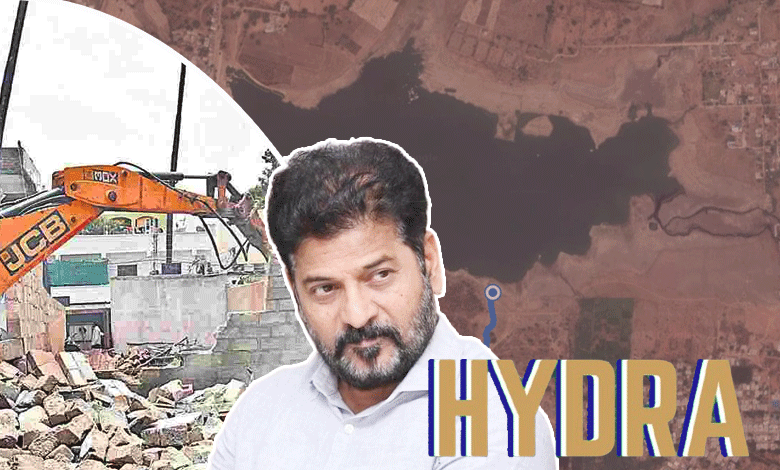Revanth Reddy’s Bulldozer: AIMIM and BRS Critique Telangana’s HYDRAA Operations—Understanding FTL and Buffer Zones for Property Safety in Hyderabad
Revanth Reddy's Bulldozer Strategy and the Telangana Government's HYDRAA operations facing criticism from AIMIM and BRS. Understand the implications of Full Tank Limits (FTL) and buffer zones on property safety in Hyderabad.

- HYDRAA Launch and Demolitions
- Political Reactions and Criticism
- Demolitions have Sparked Debates
- KT Rama Rao Criticism
- Revanth Reddy cites the Bhagavad Gita
- Ranganath Warns Owaisi's College on Illegal Structures
- Decline in Property Registrations
- Focus on Illegal Structures
- Understanding FTL and Buffer Zones
- What is Full Tank Limit (FTL)?
- What is the Buffer Zone?
- How to Check Property Status
The political landscape in Telangana has been shaken by the bold actions of Chief Minister Revanth Reddy. His administration’s newly launched campaign, spearheaded by the Hyderabad Disaster Response and Asset Protection Agency (HYDRA)—often referred to as HYDRAA—aims to reclaim government lands, water bodies, and buffer zones that have been encroached upon by politically connected individuals. As this initiative garners widespread attention, opinions are divided. While some applaud the government’s decisive action, others are raising eyebrows over the selective targeting of certain influential figures.
In this article, we will delve deep into the operations of HYDRAA, the controversies it has stirred, and its implications for the citizens of Hyderabad. We will also explore critical concepts like Full Tank Limit (FTL) and buffer zones to help residents understand the impact of these regulations on their property.
The Emergence of HYDRAA and Its Controversial Start
Launched in July 2024, HYDRAA has already made headlines with its demolition of illegal structures encroaching on government land and critical water bodies around Hyderabad. One of the most significant actions was the demolition of the N Convention Centre, owned by Tollywood actor Akkineni Nagarjuna, in August 2024. This landmark venue, known for hosting elite weddings, became a focal point for discussions around the bulldozer strategy of Revanth Reddy, revealing the administration’s intent to uphold the law. Continuing this crackdown on illegal structures, HYDRAA also demolished alleged unauthorized constructions at a Kavuri Hills Park in the Madhapur area.
In a decisive move, Sangareddy authorities demolished illegal constructions on government land in Kishtareddy Peta village, Aminpur Mandal. Using heavy machinery, including a JCB excavator, they brought down unauthorized buildings on Survey Number 164, which were reportedly built without proper permits. The demolition was carried out under strict supervision to ensure compliance with directives against encroachments on government land.
High-Profile Demolitions: A Double-Edged Sword
While the demolitions have been celebrated by some as a courageous stand against corruption, they have also drawn criticism from various political parties, including the Bharatiya Janata Party (BJP), All India Majlis-e-Ittehadul Muslimeen (AIMIM), and Bharat Rashtra Samithi (BRS). These parties have accused HYDRAA of being politically motivated, targeting opposition leaders while letting others off the hook.
Key Highlights of Controversial Demolitions:
- N Convention Centre: The demolition sparked widespread debate over government accountability.
- Targeting Opposition Figures: Prominent leaders have expressed concerns about the legality and motivations behind these actions.
- Political Repercussions: The controversy has fueled tensions in Telangana’s political arena, raising questions about fairness and justice.
Why HYDRAA’s Actions Have Stirred Controversy
The operations carried out by HYDRAA have created a climate of fear among property owners, especially those with structures near water bodies. The opposition claims that these demolitions are not just about protecting the environment but are also a means for the ruling party to exert political pressure on its rivals.
Opposition Voices: Questions of Legitimacy
BRS working president KT Rama Rao (KTR) has been vocal in his criticisms, questioning the government’s selective enforcement of laws. KTR remarked, “If there is encroachment, I have no objection to the demolition. But what about other Congress leaders who have encroached on Full Tank Levels (FTL) and buffer zones?” This statement emphasizes concerns over bias and favoritism in the HYDRAA operations.
Revanth Reddy’s Response: Dharma and Duty
In a bid to justify his government’s actions, Revanth Reddy has invoked the Bhagavad Gita, claiming that his demolitions are part of his dharma (duty) to protect Hyderabad’s precious water bodies and government lands from encroachment. He has framed the BRS as the main antagonist in this narrative, portraying himself as the champion of environmental conservation.
The Rhetoric of Protection
Revanth’s bold rhetoric has polarized public opinion in Telangana. The “bulldozer politics” he employs has drawn comparisons to similar tactics used by other Indian leaders, including Yogi Adityanath in Uttar Pradesh. This association has further intensified the political discourse surrounding his administration.
The Impact on Hyderabad: Economic Concerns and Real Estate Woes
The repercussions of HYDRAA’s operations are not limited to the political sphere; they have also significantly impacted Hyderabad’s real estate market. The fear of demolition has led to a sharp decline in property registrations, adversely affecting the economy.
Statistics Speak: Decline in Property Registrations
- July 2024: 58,000 property registrations recorded.
- August 2024: This number dropped to just 41,200, leading to a revenue loss of approximately ₹320 crore.
The economic fallout has left developers and potential buyers wary of future investments in Hyderabad.
HYDRAA’s Focus: Not on Slums
Despite concerns that HYDRAA’s actions might extend to slums and areas occupied by marginalized communities, officials have reassured the public that their focus is strictly on illegal commercial structures, resorts, and high-end residential projects. Commissioner A.V. Ranganath emphasized that slums would not be targeted, aiming instead to protect the environment and government assets.
A Commitment to Greater Good
Ranganath’s remarks underline the agency’s commitment to the greater good of the community. He stated, “What needs to be kept in mind is the greater good for the greater number of people,” echoing a Benthamite philosophy that seeks to maximize utility for the majority.
Opposition’s Allegations: Are Influential Figures Evading Action?
As HYDRAA continues its operations, questions arise regarding the commitment to equitable enforcement. Critics allege that certain influential figures, including Tirupati Reddy, brother of Revanth Reddy, have been issued notices but have not yet faced demolition.
A Perception of Selective Justice
This perceived selective enforcement has sparked outrage among citizens, who feel that while ordinary residents face the brunt of HYDRAA’s actions, powerful individuals are shielded from consequences. Local residents, particularly from the Durgam Cheruvu area, have begun to voice their concerns about the government’s intentions.
Ranganath Warns Owaisi’s Fatima College Over Illegal Constructions
In a significant warning, Hydra Commissioner Ranganath addressed the illegal constructions at Owaisi’s Fatima College near Chandrayanagutta Salakam pond, stating that while action is forthcoming, a temporary reprieve is granted to avoid disrupting the academic year. “We are providing time to remove these illegal structures to ensure students are not negatively impacted,” Ranganath emphasized. However, he made it clear that strict action will follow if the illegal constructions are not dismantled, asserting, “Whether it’s Owaisi or Mallareddy, the law is the same for everyone.” His comments have sparked widespread discussion in the city as residents await the next steps.
Owaisi Questions Government’s Selective Demolition Policy
The demolition of illegal structures in Hyderabad has ignited a debate in Telangana, with opposition leaders raising concerns over the government’s actions. AIMIM MP Asaduddin Owaisi questioned the state government about its approach to structures within the Full Tank Level (FTL) zone of Hussain Sagar Lake, criticizing its selective demolition policy. He specifically asked if the Necklace Road, also located within the FTL zone, would be the next target for demolition.
HYDRAA Directs Jayabheri to Remove Encroachments
HYDRAA Directs Jayabheri Constructions to Remove Encroachments on Rangalal Kunta Lake in Gachibowli. The Hyderabad Disaster Response and Asset Monitoring and Protection Agency has ordered Jayabheri Constructions, owned by actor Murali Mohan, to dismantle illegal structures encroaching on the Full Tank Level (FTL) and buffer zone of Rangalal Kunta pond. The company has been given 15 days to comply, as residents raised concerns about the environmental impact of blue sheet walls built two meters into the FTL area.
The Road Ahead: HYDRAA’s Expanding Jurisdiction
With discussions underway to extend HYDRAA’s jurisdiction beyond Hyderabad, the political and social implications of this move remain to be seen. For now, Revanth Reddy’s bulldozer strategy continues to shape Telangana’s political landscape, inciting both fervent support and heated criticism.
Full Tank Limit (FTL) and Buffer Zones: The Core of HYDRAA’s Mission
A significant focus of HYDRAA’s demolitions has been structures built within the Full Tank Limit (FTL) and buffer zones of lakes in Hyderabad, such as Osman Sagar and Himayat Sagar. The scrapping of Government Order (GO) 111, which protected these critical catchment areas, has led to a wave of legal disputes regarding land encroachment, placing HYDRAA at the center of regulatory enforcement.
Understanding FTL: A Safety Precaution
Full Tank Limit (FTL) refers to the maximum water level that a lake can reach during extreme weather conditions. This boundary ensures that, even during heavy rainfall, water is contained within a designated zone, thereby protecting both the environment and adjacent settlements from flooding.
The Significance of Buffer Zones
Buffer Zones serve as additional safety margins beyond the FTL boundary. For larger water bodies, this zone extends 30 meters (approximately 100 feet) from the FTL, while for smaller bodies, it is limited to 9 meters (around 30 feet). Permanent structures are not permitted in these zones, although certain activities, such as farming or green spaces, may be allowed.
Understanding Full Tank Limit (FTL) and Buffer Zones: A Guide for Hyderabad Residents
In light of the ongoing debates surrounding HYDRAA’s actions, it is crucial for residents to understand the implications of Full Tank Limit (FTL) and buffer zones on their properties. Many landowners have expressed concerns about whether their land is at risk of demolition due to encroachment on these critical areas.
For detailed information on lake management and FTL specifications, visit the official HMDA Lakes website at HMDA Lakes. This resource is essential for anyone looking to ensure compliance with local laws and to protect Hyderabad’s natural resources.
What is Full Tank Limit (FTL)?
FTL designates the maximum water level a water body can reach during periods of heavy rainfall. The FTL boundary serves as a precautionary measure to ensure that water is contained within a designated area, protecting both the environment and local communities from flooding.
What is the Buffer Zone?
The Buffer Zone is an additional safety margin beyond the FTL boundary, typically extending 30 meters from the FTL for larger water bodies and 9 meters for smaller ones. This zone is critical for maintaining the ecological balance and preventing encroachment.
Common Misconceptions Cleared
There is a lot of misinformation regarding these boundaries, including exaggerated claims about the distance that should be maintained from lakes. It is important to rely on official sources for accurate information.
How to Check if Your Property is Affected
Residents can utilize the Dharani Portal, a government platform that provides detailed maps for landowners to determine if their properties fall within any restricted zones.
What Happens if Your Land Falls in the FTL or Buffer Zone?
If your property is identified within these zones, construction is generally prohibited. Existing permissions may require additional consultations with local authorities to ensure compliance.
Conclusion
Revanth Reddy’s bulldozer initiative through HYDRAA has significantly reshaped Telangana’s political landscape. While many view its demolitions as essential for environmental protection, concerns about fairness and accountability persist due to the selective nature of these actions.
As HYDRAA continues to act against illegal structures, opposition parties will likely scrutinize the government’s motives. The future of HYDRAA’s reach remains uncertain, but it has undoubtedly introduced a new era of bulldozer politics in Telangana.
For property owners in Hyderabad, staying informed about Full Tank Limits (FTL) and buffer zones is crucial. Utilize resources like the Dharani Portal and consult local authorities to avoid legal issues related to land encroachment. For ongoing updates, follow our reports and consult legal experts for specific property inquiries.

